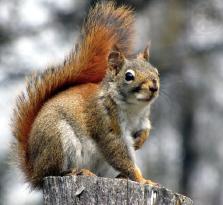Also a bit naughty by nature, this fluffy tailed rodent is the neighbour who demands attention. Able to devastate the interior of any cottage that they can gain access to faster than you can say Tamiasciurus hudsonicus, these feisty little squirrels are hard at work all year long.
Fiercely territorial, individual squirrels protect their foraging territory and their central caches of food. A confrontation between two red squirrels often entails a lot of tail flicking, chattering, and foot stomping. Their diet mainly consists of the seeds of conifers like pines and nuts like acorns, but they are omnivores and will also eat berries, mushrooms (even those toxic to humans), bugs, mice, eggs, and small birds, among other things. The squirrel whose island I live on is not above licking the barbeque grill and rattling it loudly in the hours just before dawn, or nibbling the tender leader of a pine seedling I am trying to cultivate.
The Latin word for squirrel, sciurus, is derived from two Greek words, skia, meaning shadow, and oura, meaning tail. Combining the two means loosely “one that sits in the shadow of its own tail”. The red squirrel’s bushy russet tails are used for balance as they jump nimbly from tree to tree, as well as for signalling annoyance with intruders. Annoyance with intruders is in fact the defining characteristic of red squirrels, and perhaps you have heard their series of loud calls and barks as you have dared to step outside of your cottage onto the squirrels’ territory. Even though your name may on the deed, it’s plain the undeniably cute red squirrel really owns the property. Proof that a fluffy tail goes a long way in life- just ask a rat or a mouse!
For more detailed information on the habits and ecology of red squirrels, see https://www.aiwc.ca/blog/six-things-to-know-about-red-squirrels/ and https://en.wikipedia.org/wiki/American_red_squirrel
